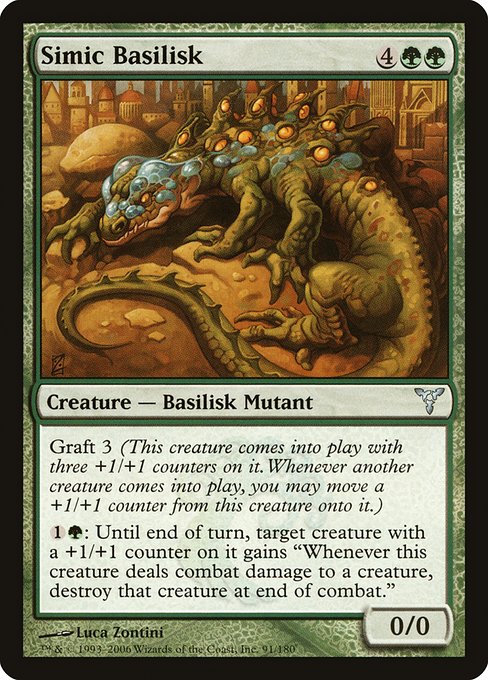
Image courtesy of Scryfall.com
The Creative Ripple: Fan Design and the Simic Basilisk
If you’ve ever peeled back the layers of a green-blue tinkerer’s toolkit in Magic: The Gathering, you’ve probably met the Simic Combine’s signature vibe: biology as a craft, evolution as a game plan, and mutations as a laboratory-level art form 🧪🧬. The Simic Basilisk—caught in Dissension’s experimental fold—embodies that ethos: a creature who enters the battlefield on a grafted foundation, then invites you to rewrite the board’s biology as the game unfolds. Its presence on the table isn’t just about raw power; it’s a blueprint for how fans imagine growth, attachment, and adaptation on the card itself. The artwork by Luca Zontini captures that clinical, slightly absurd elegance—mutant biology meets lab-lit glamour—and invites fan designers to riff on what “growth through graft” could look like in a hundred colors and two hundred iterations 🎨⚗️.
Graft, Growth, and Group Play
Simic Basilisk is a creature with a purposefully unconventional stat line: a six-mana commitment (4 generic and 2 green) for a thing that doesn’t even contribute a big number until you start moving counters around. “Graft 3” means it enters the battlefield with three +1/+1 counters, a seed you can spread outward as new creatures join the fray. The elegance here is mechanical loneliness converted into collaborative strength: as other creatures enter, you may move a +1/+1 counter from the Basilisk onto the newcomer. The result is a rolling crescendo of bodies swelling with every arrival, a living testament to the Simic motto of “build, adapt, survive.” This mechanic invites fan designers to dream up counter economies—how many counters should travel, which new threats benefit most from graft, and where the line between growth and overextension lands 🧙🔥💎⚔️.
And then there’s the activated ability, a thoughtful, green-tinged trick: for {1}{G}, you can give a target creature that already carries a +1/+1 counter on it a temporary bonus—until end of turn, that creature gains a powerful conditional line: if it deals combat damage to a creature, that creature is destroyed at the end of combat. It’s not a one-card win condition; it’s a strategic tool that lets you turn a small army into a ticking clock, or shadow a key blocker with a self-destruct plan. Fan variants often reimagine this timing window—experimenting with different costs or adding extra triggers—to weave grafted themes into victory paths that feel both elegant and iconic for Simic play 🎲.
“Graft isn’t just a mechanic; it’s a philosophy. It asks: what happens when growth reaches out to touch another creature? The Basilisk asks you to answer with tempo, caution, and a little lab-sinister flair.”
Flavor, Frame, and the Artistry of Simic Design
The Basilisk’s flavor text—mutant basilisk with grafted vitality—resonates with fans who love the idea of biology as a tool for strategy. In the broader Dissension era, Simic’s theme leaned into laboratory aesthetics, modular upgrades, and a sense of natural philosophy applied to battle. The card’s 2006 frame (frame set 2003-era with the Dissension slot) complements the concept: a creature that looks part beast, part experiment, part ecosystem engineer. Fans naturally explore fan art that pushes the Basilisk toward more overt “lab monster” vibes, or toward a gentler, more patient growth arc where counters accumulate alongside a careful tempo plan. The real strength here is how a single card becomes a cultural prompt: what if graft could be the backbone of a whole deck, or what if the Basilisk were redesigned as a fully mutated champion under a different cycle of green mana creatures? That curiosity is what makes fan design so important to MTG’s living fabric 💡🎨.
Luca Zontini’s illustration—characteristic for its sharp lines and a sense of hybrid vitality—provides a template for fan art that balances the wildness of mutation with the controlled precision of a scientist’s bench. When fans study this card, they not only imagine new mechanics; they envision new color relationships, new creature types, and new ways to narrate the Simic worldview: growth through deliberate, sometimes intrusive, adaptation. It’s a reminder that design isn’t just about numbers; it’s about how a card feels when you play it, and how it speaks to the shared stories of the multiverse 🧙🔥.
Fan Design as a Bridge to Modern Play and Collector Culture
From a gameplay perspective, Simic Basilisk sits on a crossroads: it rewards you for a patient, enter-the-battlefield rhythm and encourages you to leverage every new body that arrives. In a modern context, this kind of graft-centric approach plays well with green’s ramp and multi-creature synergies, letting players craft boards that feel 'alive' with counter management and tempo swings. For collectors and casual players alike, the card’s uncommon rarity, its foil and nonfoil finishes, and the distinctive Simic watermark contribute to a sense of rarity that’s accessible but still intriguing. Even its price point—modest by today’s standards—helps keep the design conversation grounded: fans can prototype new graft concepts without chasing over-the-top collectability, and official sets can observe which ideas resonate with the community 🧩💬.
As you surf the fan-design currents, it’s also worth noting how Dissension’s lifecycle as a set influenced online conversations. The combination of graft with Enter-the-Battlefield timing sparked riffs on “growth acceleration,” “counter distribution,” and even “mutant collaboration” aesthetics that show up in fan-made cards, homebrew formats, and custom playmats. The art, the mechanics, and the story of Simic Basilisk become a shared playground where players test ideas, measure balance, and celebrate the joy of mutation turned into strategy 🎲.
For fans who like to keep the journey portable—whether you’re at a warm-up game night or a busy convention floor—the right gear can help you focus on the game you love. And speaking of gear, if you’re stocking pockets and sleeves between rounds, consider a MagSafe card holder that keeps your essentials secure between duels. It’s a small detail that lets you stay in the moment as your board grows more elaborate with each passing turn.